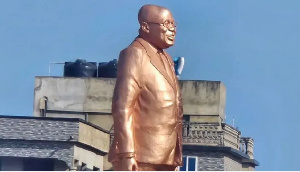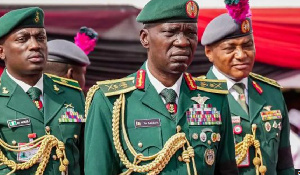Opinions of Tuesday, 18 January 2005
Columnist: Dozie Malya
Why Dagbon May Split a Second Time in nearly 800 Years -PART I
The killing of the King of Dagbon Ya-Na Yakubu Andani II and 40 of his elders may be another knickpoint in the history of Dagbon. Many people would always rejoice at a knick-point especially when it ushers a new era of prosperity. Sadly in the case of the current potential knick-point in Dagbon it is one that is more likely to wrought misery and retrogression.
It appears the murder of the Ya-Na and others in 2002 is a knickpoint that would split dagbon for the second time in the Kingdom?s nearly 800 year history. Some people reading this article may call me a pessimist, or doomsday prophet. However, my prediction / prophesy is based on the analysis of the political history of Dabgon shortly before the death of Na Gbeewah (The 3rd king of Greater Dagbon). In fact Na Gbewah?s death was precipitated by a near similar event, and for me that event appears to be history repeating itself. The event of reference is the conspiracy to and murder of the crown-prince Kufogu by his own brother Zirli about 1300 AD. According to Dagbon oral history documented in ?The History of the Dabgamba People? (By Roland Issifu Alhassan-The first Dagbon Lawyer), Zirli conspired with other Dagbon warriors to murder Kufogu. The conspirators covered a dug-out pit with skins and cushions, and lured the unsuspecting Kufogu to sit on the skins. Kufogu obviously fell into the pit and the conspirators pour several pots of hot pito on him, killing him instantly. The news was relayed to Na Gbeewah and the Dagbon community by the talking drum as follows- ?Zirli has killed Kufogu?.What a tragedy?!!. Na Gbewah who was at the time very old, died upon hearing the news of the murder of his crown-prince. Gbewah was so saddened by the event that he melted into the ground. The capital of Dagbon was then in Pusiga (Near Bawku in Upper East Region).
The murder created disunity among the children of the King and among the people of Dagbon, but any dissatisfaction was muted. No one (including the 4 other sons and daughter of Gbewaah) was bold enough to stand up against Zirli for the murder of Kufogu. Zirli unleashed a reign of terror on Dagbon and perhaps found a supporter in Tohagu, (who was the next in line to become Ya-Na).
After the death of Zirli, Tohagu became Ya-Na, and that was when the dissatisfaction grew louder. The rest of the brothers led by Sitobu and Mantambu rebelled against Tohagu, and this led to the split in Dagbon. Tohagu relocated the capital of Dagbon to Gambaga /Nalerigu in order to flee from the rebellion. Following the fighting between brothers Sitobu and Mantambu moved to the south of the kingdom and established their capitals at Yendi and Bimbilla. The Moshi Kingdom no longer bothered to report to Pusiga or Gambaga/Nalerigu. Thus, Greater Dagbon became 4 states of Moshi, Mamprugu (Mamprusi), Dagbon and Nanun ( Nanumba).
There are parallels between this historical event and the current event (the murder of the Ya-Na). Their similarities relate to the following:
1. Kufogu?s murder involved a conspiracy and there appears to be conspiracy in the current case.
2. The central government in the person of Gbewaah was too old and weak to act in order to institute justice. The powers that be today (Ghana Government) appears to be weak to bring any justice. The difference is that in the case of Gbewah the incidence was so painful he preferred to die. However, in the current case the central government appears to hold an attitude of indifference, laisse faire or apathy, or perhaps is simply feet-dragging.
3. At the time of Zirli any one who dared to raise a voice or showed sympathy would have been intimidated or killed. Today, the same is happening as no one can lay blame on Governement without being accused of something. Basic questions such as; why were the telephones and electricity out in the three days of mutiny or how come the Yendi police failed to ask for help if the had no capacity to intervene, cannot be asked. No one can talk about the incompetence of those involved in Government, who were capable of stopping the murders without being sued for lack of evidence.
4. There was dissatisfaction in the dagbon community at the murder of Kufogu and today there is dissatisfaction in Dagbon and Ghana for the apparent lack urgency, decisiveness on the part of Government to swiftly and efficiently apply the rules of law.
5. There was no justice for Kufogu and there is still no justice for Ya-Na Yakubu Andani and his elders
6. The name of one of the central characters the time (Kufogu) bears resemblance to th current President John Kuffuor; perhaps he has a Dagomba ancestry.
Why a split will occur in Dagbon:
The findings of the Wuaku commission contained many claims and counter-claims, and conclusions as to the nature of the conflict that led to the murder of the Ya-Na. However, the concluson that the Ya-Na disd in a war stands out for me as ridiculous, shameful, disturbing and above all dishonest. As a person interested in peace for Dagbon and and Ghana, and a supporter of justice for all world citizens, it is disheartening to know that a supposedly competent person in the field of Jurisprudence-Nana Akuffo Addo was the Attorney General who accepted such a conclusion.
The conclusion that the Ya-Na died in battle suggests that the Ya-Na went out of his Palace to fight with other people who were defending the compound. According to the traditions of Dagbon, such is not the case. It is simple logic to know that the King did not go to the war front, just as the Abudu regent Boling-lana would not have been at the ?front? of the so called war. Further, evidence from the compound does not suggest these people were fighting but rather were scared or surrendered. So many of the people who died were found in a single location, that is what makes one wonder whether they were really fighting. Strategically, no one would be fighting a war and stupidly assembly in one spot, because you make yourselves easy target. I am no forensic scientists, but simple logic tells me that the fact that the bodies of the majority of the 40 elders were in a single location in burnt-down palace suggests that they were cornered and perhaps had even surrendered. According to rules of war (And I mean International, Islamic and traditional dagbon rules of War), when an enemy surrenders you should not kill the enemy. The recent prosecution of a United States soldier for killing a wounded and unarmed Iraqi man in mosque in Fallujah is reminder that when a person kills an unarmed person it is a crime. One wonders how Nana Akuffo Addo (a unique brain in his own right, and stalwart in many respects in the current government ) could have accepted this shameful conclusion of the Wuaku Commission. Perhaps he was asked not to challenge this conclusion otherwise I honestly believe he knows that that conclusion is flawed. Well, given that the Ya-Na naturally would not have been at the fighting (even if there was a real war), it is clear that the murderers killed a king who was not himself fighting and was at home -perhaps unarmed. It will be surprising if this picture does not come across to any reasonable person as murder and a crime. Well the government of Ghana accepted the Wuaku commission conclusions that these people died in war. The question is how do the Abudus involved in the killings feel about the event? Many Dagombas believe in God, either as traditionalist, Mulsims or Christians. How could they hate their fellow Dagombas so much? Are the killers able to imagine how those dying people felt in that terrible one moment when they were being shot? Are the killers able to imagine how the families of those killed still feel today when no one has been charged? Are the killers able to understand that their action has added a web of complex tangles to a conflict that was more acceptably resolved by the supreme court of Ghana? It is these questions and perhaps the points raised above in relation the historical killing of Kufogu that will lead to the split of Dagbon for the second time in nearly 800 years.
Many people think that if the Ya-Na is buried there will be peace and things will simply fall in place like a jig-saw puzzle. This is a contention that loses sight of the complexity of the conflict and the aspirations of the parties in respect of retaining the Nam (Skin of Yendi). Several writers have called for justice before the burial of the Ya-Na, and though the government has not responded to this request, it on this the peace and unity of Dagbon hinges.
I will analyse the reasons why a split will occur from the hopes and mentality of the Andani and Abudu gates in Part II.
Entertainment










